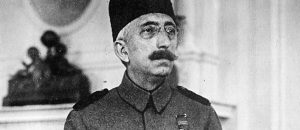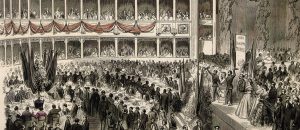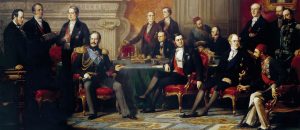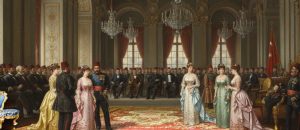The reign of Sultan V. Mehmed Reşad symbolizes a transition period in the Ottoman Empire where the institution of the sultanate ceased to be the center of absolute power and transformed into a symbolic representation. Sultan Reşad, who ascended the throne in 1909 with the support of the Committee of Union and Progress (İttihat ve Terakki Cemiyeti) following the March 31st Incident (31 Mart Vakası), was an inexperienced and elderly monarch who had spent his long years as a prince (şehzadelik) living a kind of prison life within the palace. During his era, Dolmabahçe Palace, once the center of absolute power, had become the residence of a “representative monarch” (temsili hükümdar) whose powers were restricted, and who merely approved the decisions of the Union and Progress administrators who held the real power.
The Long Wait and an Inexperienced Monarch
Sultan V. Mehmed Reşad lived under strict surveillance in the Crown Prince’s Apartment (Veliaht Dairesi) of Dolmabahçe Palace as the Crown Prince (Veliaht Şehzade) throughout the 33-year reign of his elder brother, Sultan II. Abdülhamid. Due to his brother’s suspicion, he was kept completely away from state affairs, his contact with the outside world was restricted, and he was not allowed to gain political experience. This long and passive wait shaped his character, making him a more docile, peaceful, and unpretentious personality. When he ascended the throne at the age of 65, during one of the most turbulent periods of the empire, he lacked the political will and experience necessary to govern the state. This situation made him an ideal candidate for a monarch in the eyes of the Committee of Union and Progress (İttihat ve Terakki Cemiyeti).
A Reign in the Shadow of the Committee of Union and Progress
The real power that brought Sultan Reşad to the throne was the Committee of Union and Progress (İttihat ve Terakki Cemiyeti), which had proclaimed the Second Constitutional Era (II. Meşrutiyet) and consolidated its power through the March 31st Incident (31 Mart Vakası). With the constitutional amendments (Kanun-i Esasi) enacted during this period, the Sultan’s powers were significantly restricted. Absolutist powers such as arbitrarily dissolving the parliament, appointing, or dismissing the Grand Vizier (sadrazam) and ministers were taken away from him. Sovereignty now resided with the Chamber of Deputies (Meclis-i Mebusan), which acted in the name of the “nation,” and executive power was virtually in the hands of the government (Bâb-ı Âli) controlled by Union and Progress.
In this new order, Sultan Reşad’s role was reduced to that of a unifying and symbolic head of state, similar to a constitutional monarchy in England. Dolmabahçe Palace was now merely an office where the decisions made by powerful figures such as Enver, Talat, and Cemal Pashas were approved by the Sultan. The Sultan did not have the power to object to government decisions; his duty was to represent the continuity of the state, participate in ceremonies, and symbolize the unity of the nation.
Symbolic Role in the Balkan Wars and World War I
Sultan Reşad’s reign witnessed catastrophes such as the Balkan Wars (1912–1913), during which the empire experienced its most tragic territorial losses, and World War I (1914–1918), which led to its demise. Even during these critical periods, the Sultan’s power to intervene in events was extremely limited. A vital decision, particularly the empire’s entry into World War I on the side of Germany, was made by Enver Pasha and the Union and Progress leaders; the Sultan’s role was merely to approve this situation and, in his capacity as Caliph, to declare “Cihad-ı Ekber” (Holy War).
During this period, the Sultan largely undertook duties such as raising public morale, encouraging soldiers, and serving as the symbol of the nation’s unity during difficult times. He inspected armies, visited hospitals, and appeared before the public at ceremonies. However, the strategy and management of the war were entirely under the control of the Bâb-ı Âli (Sublime Porte).
A Dull Palace Life in Dolmabahçe
Palace life in Dolmabahçe during the reign of Sultan Reşad also took on a duller and more modest character, not reflecting the glory of the past. Due to continuous wars and economic difficulties, the glittering feasts and grand invitations held during the time of Sultan Abdülaziz were no longer organized. Sultan Reşad himself had a character that disliked ostentation, preferring to live a devout and simple life. The Palace had transformed from being the heart of political intrigue and international diplomacy into a quiet residence where an elderly monarch carried out his silent and symbolic duty.
Conclusion
In conclusion, the reign of Sultan V. Mehmed Reşad is a turning point in the history of Dolmabahçe Palace and the institution of the sultanate. During his period, while the “throne” continued to exist, “power” passed de facto and legally to the Bâb-ı Âli, meaning the Committee of Union and Progress government. Sultan Reşad is the first Sultan to transition from a ruler with absolute power to a symbolic head of state operating within constitutional limits. In his person, Dolmabahçe Palace ceased to be a center from which the empire was governed, becoming merely a representative place where the head of state resided. This was the silent farewell of a centuries-old tradition and a painful step toward the parliamentary system.



















